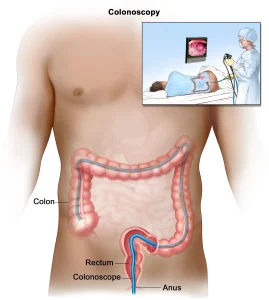Overview
Diagnosis of Anal Cancer
Diagnosing anal cancer involves a combination of physical exams, imaging tests, and biopsies to confirm the presence and extent of the disease.
Examining the anal canal and rectum
-
During a digital rectal exam, a healthcare professional inserts a gloved, lubricated finger into the anus to feel for growths or abnormalities.
Anoscopy
-
A thin, flexible tube called an anoscope is inserted into the anal canal to provide a detailed view of the area.
-
Tissue samples may be collected during this procedure for biopsy testing.
Imaging tests
-
Imaging helps determine the location, size, and spread of cancer. Common tests include ultrasound, X-ray, CT scan, MRI, and PET scans.
Biopsy
-
Tissue samples collected during an anoscopy are examined in a lab to confirm cancer diagnosis.
-
Additional tests on the biopsy sample provide information about cancer cell type and aggressiveness, guiding treatment planning.
Staging
-
Staging determines whether cancer has spread to lymph nodes or other parts of the body.
-
Stages range from 1 to 4, with stage 1 being localized and stage 4 indicating metastatic disease.
-
Accurate staging is essential for choosing the best treatment approach.
Treatment of Anal Cancer
Treatment depends on cancer stage, overall health, and patient preferences. Common approaches include chemotherapy, radiation therapy, surgery, and immunotherapy.
Combined Chemotherapy and Radiation
-
Most anal cancers are treated with a combination of chemotherapy and radiation, which work together to destroy cancer cells.
-
Chemotherapy: Uses strong medicines administered via IV or pills to target cancer cells throughout the body.
-
Radiation therapy: Uses high-energy beams to kill cancer cells at the tumor site, typically given daily over several weeks.
Surgery
-
Small anal cancers: May be removed surgically if the tumor is small and does not affect the anal sphincter muscles.
-
Persistent or resistant cancer: Procedures such as abdominoperineal resection (APR) may remove the anal canal, rectum, and part of the colon. Waste is redirected through a stoma and colostomy bag.
-
Surgery may also be combined with chemotherapy and radiation for better outcomes.
Treatment for Metastatic Cancer
-
Chemotherapy alone may control cancer spread.
-
Immunotherapy helps the immune system target and destroy cancer cells that evade normal defenses.
Palliative Care
-
Palliative care focuses on relieving pain and symptoms while supporting quality of life.
-
Care teams may include doctors, nurses, and specialists who coordinate with ongoing cancer treatments.
-
Integrating palliative care alongside other therapies can help patients feel better and live longer.
Key Takeaways
-
Early diagnosis through exam, anoscopy, biopsy, and imaging is crucial for effective treatment.
-
Chemotherapy and radiation are the mainstays of treatment for most cases.
-
Surgery is reserved for small localized tumors or cancers resistant to other treatments.
-
Palliative care and supportive therapies improve quality of life during treatment.
Advertisement

